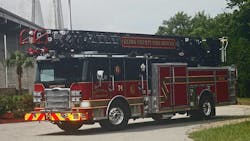Chief: GA Fire Department May Need Tax Hike to Stay Afloat
The Glynn County Fire Department’s reserves will likely run out within four years at the current budgeted spending rate, but the fire chief believes he has more than enough time to get spending back on track.
It may take more than just some budget cuts, however.
“I know it’s a dirty word, but ad valorem taxes may need to be increased,” said R.K. Jordan, chief of the county fire department.
During a recent county commission discussion of the upcoming fiscal year’s budget, interim chief financial officer Tamara Munson delivered the news that the fire department’s reserves — which are separate from the county’s rainy-day fund and general reserves — are dwindling.
“We have a fund balance of $4.4 million, so at current spending levels we could continue for three or four more years in the fire fund,” Munson said during the meeting last week.
The department’s current fiscal year budget included drawing $616,456 from reserves. It anticipates pulling out another $678,355 to balance the scales.
“There is no single culprit,” Munson said Thursday. “The overall expenses are more than the overall revenues in that fund so there is a deficit and a need to use fund balance.”
Jordan feels the reality is less dire.
“I’m going to say (we have) a solid eight years (until the department’s reserves run out),” Jordan said Thursday.
He said it is true that if the department continues to spend as budgeted, its reserves will run dry in about four years.
The budget approved at the beginning of the July 1 fiscal year doesn’t tend to reflect how much the department actually spends, however.
“Every year we turn money back in (to the reserves), so that does extend it out,” Jordan said. “This year, we returned about $400,000 into the fund.”
He said the $400,000 was budgeted for certain expenses that may not have been incurred for some reason or simply rolled over into the next fiscal year.
Further cuts are a no-go, Jordan said, adding he has several irons in the fire that may help prolong his estimate.
“At this point in time we’ve cut down to barebones, equipment-wise,” Jordan said. “When the engines are paid off, that will free up a lot of money.”
The county purchased a few new fire trucks over the past several years, some of which it is still paying for. Around $600,000 to $650,000 in the fire department’s annual revenue goes to paying off the engines.
“As that pays down, that will enhance what we have,” Jordan said.
Also on the table is tying the county’s ambulance fees to Medicare, which would ensure they increase as costs of living — and the cost of providing the service — rise.
“We are among the lowest in the region of ambulance transportation fees,” Jordan said.
They’re low primarily because the county hasn’t increased them from $550 a ride since 2014, he said.
Good news to an extent, but the department also has some increasing costs on the horizon in the form of the SAFER grant.
The fire department has a budget of around $11 million. Grants make up a portion of that and have gone toward the purchase of new gear, replacement of old equipment and increasing staff at its stations, ambulances and fire trucks.
One such grant, the Staffing for Adequate Fire and Emergency Response grant, offered the county a way to cut back on overtime among firefighters and emergency medical technicians, a serious problem in 2018.
For three years, it would pay roughly 60 percent of the salaries and benefits of 15 new firefighters. The grant would only cover new hires, and the county could not fire them for the three-year term.
That grant ends next year, and the county will have to take on the responsibility of paying them or letting them go.
It’s an easy choice for Jordan.
“We have a great deal of money involved in training them,” Jordan said. “Many are in the process of becoming paramedics, which greatly enhances their value to the county.”
Letting them go would revive the old overtime issues, Jordan said. Having more firefighters gives them a better response time, decreases the average dollar loss from fires and makes the county an overall safer place to live, he added.
He plans to apply for the SAFER grant again when the current one runs out in March 2021. It will count as a new grant that will require the county to hire 15 new firefighters for three years, partially on the federal government’s dime.
Of course, that doesn’t come cheap.
While he doesn’t believe the department will run out of money anytime soon, the question of raising the millage may become a necessary one to answer eventually.
Currently, the fire tax is 2.08 mills, while the EMS tax is 0.68 mills. The EMS millage applies to the entire county, while the fire department tax is not charged to properties in the city of Brunswick, on Jekyll Island or in the outlying areas of the county.
If nothing changes, finding more revenue will likely become a pressing issue within five or six years.
———
©2020 The Brunswick News (Brunswick, Ga.)
Visit The Brunswick News (Brunswick, Ga.) at www.thebrunswicknews.com
Distributed by Tribune Content Agency, LLC.
